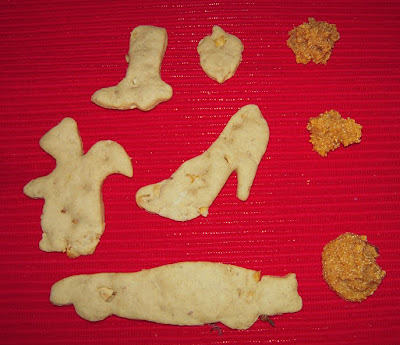 We made two kinds of treats. The first one is called Peanut Butter Puppy Poppers. These are the shaped cookies on the left side of the picture. I liked these best because they use just four ingredients (all of which you should have in your kitchen) and the dough is a good consistency for fun cookie-cutter shapes inspired by your dog's interests such as acorns, squirrels, shoes and fast cars (that one was more for Ryan actually). Here is the recipe:
We made two kinds of treats. The first one is called Peanut Butter Puppy Poppers. These are the shaped cookies on the left side of the picture. I liked these best because they use just four ingredients (all of which you should have in your kitchen) and the dough is a good consistency for fun cookie-cutter shapes inspired by your dog's interests such as acorns, squirrels, shoes and fast cars (that one was more for Ryan actually). Here is the recipe:Peanut Butter Puppy Poppers (from Bullwrinkle.com)
Ingredients
2 cups whole-wheat flour (we used all-purpose flour instead)
1 tbsp baking powder (we cut it to a half tbsp)
1 cup peanut butter (chunky or smooth)
1 cup milk
Directions:
Preheat oven to 375F. In a bowl, combine flour and baking powder. In another bowl, mix peanut butter and milk, then add to dry ingredients and mix well. Place dough on a lightly floured surface and knead. Roll dough to 1/4 inch thickness and cut out shapes. Bake for 20 minutes (ours took MUCH less time so keep an eye on them to prevent burning) on a greased baking sheet or parchment paper-lined baking sheet until lightly brown. Cool and store in an airtight container.
Carrot and Turkey Dog Treats (from all-natural-dog-treat.com)
These are actually called "Bonnie's Homemade Dog Treats" on the web site, but that isn't very descriptive. These treats are the orange-colored round mounds on the right side of the photo above. This recipe might require a trip to the store since you probably don't have all of the ingredient in your pantry. The four ingredients are cheap and easy to find, so don't worry. This recipe makes a very wet dough, so you can't make fun shapes with it but your dog doesn't really care about that.
Ingredients:
1 cup Cream of Wheat (dry)-we did not buy the instant kind
1 cup Carnation Dry Milk (lowfat and dry)
1 small jar of carrot baby food
1 small jar of turkey dinner baby food (it has green beans, squash and barley)
Directions
Mix ingredients together. Drop onto a parchment paper lined cookie sheet in size you desire. Bake at 350F until lightly browned on edges, then cool. We baked them on two cookie sheets in dime- or nickel-sized drops.





















